Ripley Entertainment Inc.'s Blog, page 218
February 24, 2020
Explosive Nostalgia: Florida Woman’s WWII Land Mine Find
Featured in Ripley's Believe It or Not!

Life along Florida’s so-called “Treasure Coast” comes with many exciting finds, especially when exploring the beaches of counties like Martin, St. Lucie, and Indian River. This region’s name refers to the Spanish Treasure Fleet, which was lost at sea in a 1715 hurricane just off the shoreline. By 1961, salvagers began recovering Spanish treasure off the coast, gaining this strip of the Atlantic international fame.
It’s little wonder, then, that locals like Jayne Wilson take beachcombing seriously. After all, they never know what they’re going to find. Hello, gold doubloons! Fast forward to April 2019 when Wilson discovered what she thought was a barnacle-encrusted plate from a long-lost Spanish galleon or pirate ship.
Only months later, did she find out she was actually in possession of a World War II-era land mine!
A Beachcomber’s Paradise
A private home health aide, Wilson loves strolling Vero Beach at sunrise with her client’s dog. On one of her morning walks along the Treasure Coast, she discovered more than she bargained for in the form of a flat brown object that looked like a giant “veggie patty.” Normally a collector of sea glass, she was delighted by the find and took it home to clean it up and decipher the mystery of its identity.
This sea glass collector assumed she had found an antique plate of some kind, either metal or porcelain. For nine months, she chipped at the plate’s outer coating, painstakingly removing the barnacles and shells that had collected on its surface. When not working on her find, she kept it in her house in a lunch box cooler filled with saltwater.
An Explosive Situation
One day, she received a panicked message from a friend. As it turns out, Wilson’s friend had just seen a post on a community web page about a man who discovered a WWII-era land mine on Vero Beach. After seeing an image of the land mine, her friend remembered the “crabby patty-looking” object sitting in the cooler in Wilson’s living room.
The realization that she’d been chipping away at a land mine for nine months stunned Wilson, but she figured that if it hadn’t already exploded, it probably wasn’t going to anytime soon. So, she brought the land mine over to her client’s house at Indian River Shores and called the authorities to pick it up. To her horror, they told her to evacuate the home immediately, and they dispatched bomb experts to the scene.
Collect Shells, Not Land Mines
According to the Indian River Shores Police Captain Mark Shaw, finding land mines on the beach is a common occurrence. But he doesn’t recommend Wilson’s approach to dealing with these finds.
Instead, he said you should assume the mine is live and ready to detonate at any moment. In other words, avoid storing it in a cooler in your living room for nine months! Authorities have since dispatched representatives from Patrick Air Force Base to investigate Vero Beach and why it keeps turning up unwanted “treasure.”
If you plan on combing through the sand, keep a watchful eye out for explosive pieces of history.
By Engrid Barnett, contributor for Ripleys.com
EXPLORE THE ODD IN PERSON!
Discover hundreds of strange and unusual artifacts and get hands-on with unbelievable interactives when you visit a Ripley’s Odditorium!
Source: Explosive Nostalgia: Florida Woman’s WWII Land Mine Find
CARTOON 02-24-2020
February 23, 2020
CARTOON 02-23-2020
February 22, 2020
CARTOON 02-22-2020
February 21, 2020
What’s The World’s Most Flammable Cheese?
Featured in Ripley's Believe It or Not!

When we heard about a semi-truck carrying 27 metric tons of cheese catching fire in Norway, it got us thinking: What’s the world’s most flammable cheese?
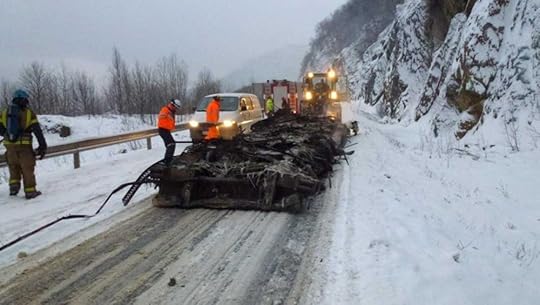
The burned cheese truck./Via Norwegian Public Roads Administration
In order to answer our burning question, we dove into research mode. You might think that heavily processed cheese products like Kraft Singles or Velveeta would be particularly susceptible to burning thanks to all that extra processing, but the internet quickly showed this not to be the case.
We stumbled onto an eerie misconception about American cheese. Many videos online featured people trying to burn American cheese slices, and it holding up quite resiliently to their efforts. Some then tried burning other cheese, noting that the different behavior proved it was real cheese. Claims about what made American cheese behave this way varied from it being unmeltable, to it being made from “fake” chemicals or even plastic.
As you can see in our tests, American cheese does melt and even burn, but because of the emulsifying salts used by food scientists in these products, its burning behavior is a little different. These salts help make the cheese very consistent throughout, meaning it actually melts more uniformly than typical cheese. That said, this helped us realize just how resistant cheese is to burning. Not because of emulsifying salts, but because of a very specific chemical called dihydrogen monoxide (water). The cheese really can’t burn until the water inside has been mostly boiled away.
Switching our approach to use a browning torch instead of a lighter, we were able to test different cheeses’ reactions to heat a little better. We weren’t looking for flames, per se, but for how quickly and intensely a cheese browned.
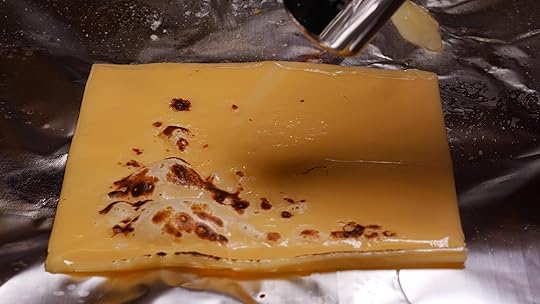
It took a lot of torching to get our American single to brown.
The process of browning is known as a Maillard reaction. This reaction describes the same browning behavior that gives toast its unique flavor. Of all the cheeses we tested, it seemed like the one that would be the most flammable would have to be some sort of combination of a dry and fatty cheese. According to the labels of our test subjects, our parmesan should have performed best, but it was our brie and swiss that seemed to brown the quickest. The wettest cheese, mozzarella, withstood browning almost completely, and though our bleu cheese caused a lot of bright orange flames from the torch, the cheese itself just melted.
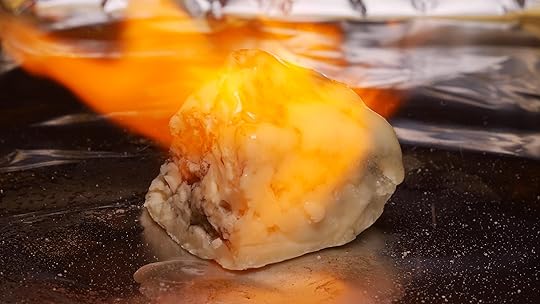
Sacré bleu!
But what about the story of the semi-truck? According to reports at the time, the truck burned so intensely, that it raged for four days before firefighters were able to get close enough to fully put it out. The flames even caused the closure of a tunnel for weeks.
The cheese aboard that truck was a goat cheese variety known as brunost. Brunost is a brown cheese that is actually made from discarded whey. Caramelized milk sugar is what gives brunost its distinctive brown color. When we exposed this cheese to the torch it browned quickly and intensely. But why?
It all goes back to our Maillard reaction. The reaction depends on amino acids and sugars reacting together. Sugar was the missing component in our other cheeses, and brunost has just enough of it to readily trigger browning.

EXPLORE THE ODD IN PERSON!
Discover hundreds of strange and unusual artifacts and get hands-on with unbelievable interactives when you visit a Ripley’s Odditorium!
CARTOON 02-21-2020
February 20, 2020
Do Airplanes Get Rid Of Toilet Waste Mid-Flight?
Featured in Ripley's Believe It or Not!

The stories are horrific. In 2012, a couple in Long Island was pelted with human excrement after an airplane flew over, trailing blackish-green waste from the lavatory. Then, in 2015, a family in Levittown, Pennsylvania, claimed human waste rained down on their daughter’s sweet 16, destroying her special day. Talk about the ultimate party pooper!
Stories like these have led many to conclude that airplanes get rid of their waste mid-flight. Considering the fact that more than 44,000 flights and 2.7 million airline passengers get transported across the U.S. each day, however, that would mean some serious airborne dookie-dodging.
So, what’s the bottom line when it comes to how airlines get rid of their waste? And why does it sometimes end up in people’s backyards? Find out more about the history of airplane toilets and how they’ve (mostly) stopped dropping frozen poop from the sky.
The Evolution of Airplane Toilets
Although accidents do still happen, airplane bathrooms have come a long way since their earliest days. At the dawn of aviation, using the bathroom mid-flight was downright medieval. It included a bucket for doing your business and a separate urinal that went overboard. Yikes!
Military planes up through the 1930s proved little better. Many of them had slits in the toilet bowl. These slits allowed the contents to dump right into the atmosphere. There was even a 1936 British Royal Air Force model that dumped waste into the sky via a pipe. The pipe itself created such a noisy whistling sound that it earned the nickname the “whistling s—house.”
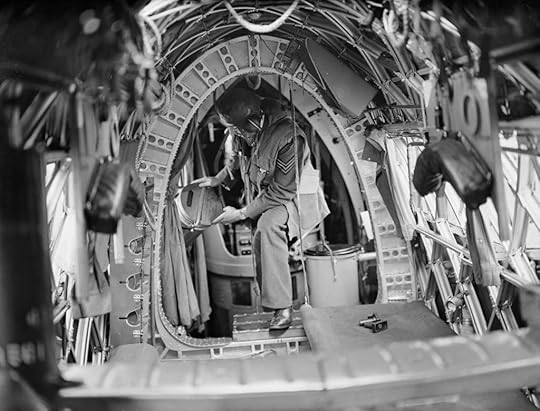
A crew member onboard a Vickers Wellington of No. 75 (New Zealand) Squadron RAF. Note the Elsan chemical lavatory to the right.
By the 1970s, airplane toilets evolved into the airborne equivalent of a Sani-hut, complete with the “blue juice” used to break down the solid waste and keep the bathroom smelling remotely tolerable. But these vintage bathrooms proved notorious for seepage and leaks. The result? The infamous “blue ice” that continues to menace unsuspecting humans down below.
Blue Ice Issues Continue
The term “blue ice” refers to waste that has leaked from an aircraft’s toilet in a liquid stage, freezing upon contact with the outside air. This blue ice becomes a significant problem as a plane prepares to land. Why? Because the change in altitude during the plane’s descent can cause the ice to break away from the plane. The ice then free falls onto the world below. Although it’s extremely rare to sustain injuries from blue ice, the Federal Aviation Administration reports that people who live within the direct flight paths of Chicago’s Midway and O’Hare airports file loads of complaints about the stuff each year.
The most modern airplanes now rely on vacuum toilets, a massive improvement over the old blue juice planes. Vacuum toilets have been used on commercial flights since Boeing adopted them in 1982. Nonetheless, many aircraft from the 60s and 70s still fly the friendly skies. As a result, there are still incidents with waste falling from the clouds, even though airplanes stopped ejecting toilet contents mid-flight a long time ago.
Dangerous Flying Excrement
The stories of human waste tumbling through the atmosphere toward Earth aren’t reserved solely to the United States. Episodes of dangerous flying excrement have been documented all over the world. In 2018, a 22 to 26 pound chunk of ice comprised of human waste fell on the village of Fazilpur Badli in India with a startling thud. Fortunately, nobody was in the path of the flying poop. But such is not always the case.

In 2016, a football-sized mass of human waste dropped on a home in the village of Aamkoh in India’s Sagar district. At the time, Rajrani Gaud was in her kitchen busy with her daily chores. The monster-sized piece of frozen excrement smashed through her roof, colliding with her. Gaud sustained shoulder injuries and had to be rushed to the hospital for treatment.
Eyewitnesses noted that had the ice block’s trajectory not been slowed by the roof, the flying turd would have smashed Gaud’s skull.
According to aviation experts, what hit Gaud was a chunk of blue ice. Although experts have traditionally thought it highly unlikely for waste to hit the ground un-melted, these two cases in India suggest otherwise.
When it’s all said and done, do the blue ice anecdotes above add up to some seriously bad luck? Well, yes. These individuals all share the misfortune of being in the wrong place at the wrong time, even though they were in their own homes. Are airplanes creating a dangerous situation for earthbound humans by ejecting toilet waste into the atmosphere mid-flight? The answer is a resounding, “No.” However, you may want to keep on the lookout for wayward waste.
By Engrid Barnett, contributor for Ripleys.com
EXPLORE THE ODD IN PERSON!
Discover hundreds of strange and unusual artifacts and get hands-on with unbelievable interactives when you visit a Ripley’s Odditorium!
CARTOON 02-20-2020
February 19, 2020
The Mystery of the Black Taj Mahal
Featured in Ripley's Believe It or Not!

As one of the most iconic and photographed locations in the world, the Taj Mahal has captured eyes and hearts for centuries. Located in Agra, Uttar Pradesh, India, this magnificent piece of architecture is one of the New7Wonders Of The World. Though it’s immediately recognizable by people all over the world, this marble masterpiece may not be as one-of-a-kind as we think. It is believed to have a twin—the mythical Black Taj Mahal.
Twin Taj Mahal
The Taj Mahal we admire today was constructed over a period of approximately seventeen years, with the work beginning around 1631 A.D. The stunning mausoleum of pure white marble was built by emperor Shah Jahan of the Mughals to honor his beloved wife and queen Arjumand Bano Begum, also known as Mumtaz Mahal, the tomb’s namesake. Boasting beautiful gardens and a mosque, this vast complex is fit for an emperor. After admiring his wife’s tribute, Shah Jahan is said to have planned a second building in the Taj Mahal’s image to have for himself.
Supposedly, it was going to mirror the design of the breathtaking original, but with one notable difference—the colors would be flipped. Instead of white marble, the edifice would be stark black. Planned to be built on the opposite side of the river Yamuna, it would have allowed the emperor and his beloved to rest across from each other in marvelous matching monuments of marble.
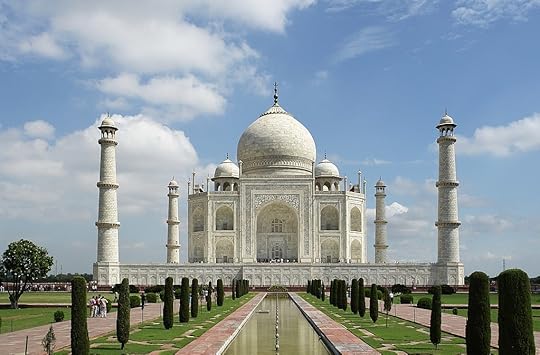
CC Yann Forget
Of course, the Taj Mahal is a popular tourist destination, visited by eager travelers from all over the world. But what happened to the legendary Black Taj?
The Truth Is Out There
The first mentions of the supposed monument were found in the writings of Jean Baptiste Tavernier, who visited the area around the time of the Taj Mahal’s construction while working on his Les Six Voyages De Jean Baptiste Tavernier. In the publication, he wrote that the construction of the mysterious black tomb had begun sometime between 1640 and 1655 A.D. At this time, the emperor was locked in deep conflict with his children. It’s understandable, then, that any ambitious building projects Shah Jahan may have had to celebrate himself would have come to an abrupt end.
After being deposed and imprisoned by his son Aurangzeb in Agra Fort, it is said that he spent his last few years as a prisoner, gazing at the Taj Mahal from his prison window. Shah Jahan died in 1666 A.D. and was entombed with his late queen, Mumtaz Muhal.
In the early 1870s, archaeologist A.C.L. Carlleyle believed he had discovered the ruins of the Black Taj Mahal’s foundations, but they proved to be nothing more than the remnants of a pond. Over a century later, the once-majestic Mahtab Bagh (Moonlight Garden) and the surrounding area had almost entirely been reclaimed by nature. Any further evidence, had any ever existed, has been made that much more difficult to unearth.
Upon the emperor’s death, his cenotaph was placed alongside that of Mumtaz Mahal, though the proportions of the two were very different. With a building as meticulously designed as the Taj Mahal, nothing tends to be left asymmetrical by design. Perhaps the emperor’s remains may never have been intended to find a home alongside his wife.

The false cenotaphs of Shah Jahan (left) and Mumtaz Mahal (right) in the main chamber.
Immortalized Mausoleum
In whatever rudimentary state the Black Taj Mahal existed, no concrete evidence seems to exist. There are no solid contemporary accounts of the proposed project beyond the words of Tavernier. Shah Jahan had given orders that the Mahtab Bagh be altered and considered part of the Taj Mahal, so there’s a possibility that the Black Taj Mahal may have been intended for this area, though there’s nothing conclusive. Archaeologists have thoroughly combed the area over the years, and the only black marble found was in small quantities believed to have simply been white marble that had aged.
The true status of the mysterious Black Taj Mahal is impossible to ascertain. Shah Jahan may never have constructed a glorious mausoleum of his own, but his memory is immortalized in the ambiguity.
By Chris Littlechild, contributor for Ripleys.com
EXPLORE THE ODD IN PERSON!
Discover hundreds of strange and unusual artifacts and get hands-on with unbelievable interactives when you visit a Ripley’s Odditorium!
CARTOON 02-19-2020
Ripley Entertainment Inc.'s Blog
- Ripley Entertainment Inc.'s profile
- 52 followers









